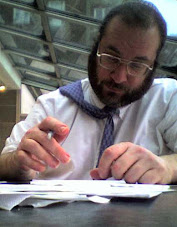יום שישי א' בטבת תשס''ז
אַשְׁרֵי הָאִישׁ אֲשֶׁר לֹא הָלַךְ בַּעֲצַת רְשָׁעִים וּבְדֶרֶךְ חַטָּאִים לֹא עָמָד וּבְמוֹשַׁב לֵצִים לֹא יָשָׁב: | 1) Happy is the man who does not walk in the counsel of the evil; And in the path of the sinners he does not stand; And in the seat of the mockers he does not sit. |
כִּי אִם בְּתוֹרַת יְהֹוָה חֶפְצוֹ וּבְתוֹרָתוֹ יֶהְגֶּה יוֹמָם וָלָיְלָה: | 2) Rather, in the Torah of HaShem is his desire; And in His Torah he occupies his thoughts day and night. |
וְהָיָה כְּעֵץ שָׁתוּל עַל פַּלְגֵי מָיִם אֲשֶׁר פִּרְיוֹ יִתֵּן בְּעִתּוֹ וְעָלֵהוּ לֹא יִבּוֹל וְכֹל אֲשֶׁר יַעֲשֶׂה יַצְלִיחַ: | 3) And he will be like a tree planted along streams of water, whose fruit he will give in its time, and whose leaf will not whither; And all that he does will succeed. |
לֹא כֵן הָרְשָׁעִים כִּי אִם כַּמֹּץ אְַשֶׁר תִּדְּפֶנּוּ רוּחַ | 4) Not so with the evil; Rather, they are like chaff that scatters the wind. |
עַל כֵּן לֹא יָקֻמוּ רְשָׁעִים בַּמִּשְׁפָּט וְחַטָּאִים בַּעֲדַת צַדִּיקִים | 5) Therefore, the evil will not stand in judgment; Nor the sinners in the congregation of the righteous. |
כִּי יוֹדֵעַ יְהֹוָה דֶּרֶךְ צַדִּיקִים וְדֶרֶךְ רְשָׁעִים תֹּאבֵד | 6) For HaShem knows the way of the righteous; And the way of the evil will be destroyed. |
This very first composition in the Book of Psalms acts as kind of an introduction to the philosophy of what is surely the greatest book of prayer ever composed. Happy will be the person who embraces the Torah, it says. That person will thrive like a well-watered tree, while the evil person who does not follow the Torah's path will amount to nothing.
You might object that the world does not look like this at all, that the evil do in fact prosper and that sometimes the righteous suffer. To a Jewish person, there are few more disturbing things in this regard than the Holocaust. The evil people, for a time, did indeed thrive, and the most righteous -- even the greatest Torah scholars and the most innocent babies -- were murdered beyond counting.
And, yet, for all the evil the murderous Nazis did, no "tree" of theirs stands, today. In the end, they amounted to nothing. They left behind no country at all, not to mention the glorious thousand-year "Third Reich" they dreamed of. Except for a few disturbed individuals on the fringes of society, no one carries on their traditions. They have been scattered to the wind.
Not so, for the righteous. Their "tree" still stands wherever you see a synagogue. Or, at this time of year, wherever you see a Hanukah light. And there is now a nation -- the state of Israel -- for all their people. We Jews, for all our struggles, still give fruit in our time. Our leaf has not withered.
That is not at all to say that the suffering and murder of the righteousness and the innocent is in any way made palatable by the fact that their people as a whole have survived. It is not to say that their pain is something we should cease to care about. This some 149 more psalms that follow this first one occupy themselves time and time again and again with crying out against suffering and pain. They pus their faith deeply in God, but never hesitate to recognize and deplore injustice.
This -- our legacy from this beautiful book -- is the way of the Jews: to abhor injustice and to cry out against it.
But the flip side of that abhoring of injustice is our deep belief _in_ justice. Few peoples of the world are so consumed by it. In our hearts we know it is worthy of pursuing. And that, eventually, the way of the evil will be destroyed. Those are the articles of faith expressed in this first of the Psalms.
#*#

